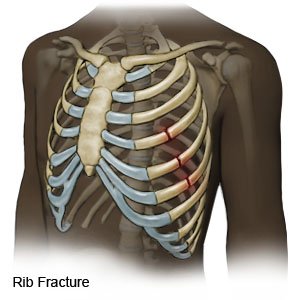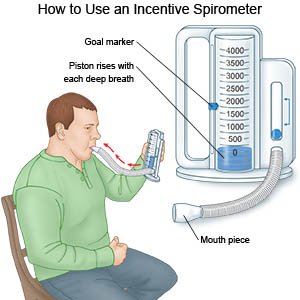Rib Fracture in Children
Medically reviewed by Drugs.com. Last updated on Apr 6, 2025.
What is a rib fracture?
A rib fracture is a crack or break in one or more of your child's ribs. Great force is needed to break the bones of children younger than 7 years. The force is higher than what is needed to break the bones of older children or adults. Greater force increases the risk for organ damage.
 |
What are the signs and symptoms of a rib fracture?
Your child may have pain in his or her chest, especially when he or she breathes deeply, coughs, or moves. You may see your child hold his or her side while breathing. You may see bruises around the area of the rib fracture.
How is a rib fracture diagnosed?
Your child's healthcare provider will ask about your child's injury and examine him or her. The provider will look for any signs of bleeding or bruising. He or she will also ask about your child's breathing and pain. An x-ray or CT scan may show the fracture or other injuries. Your child may be given contrast liquid to help the fracture show up better in the pictures. Tell the healthcare provider if your child has ever had an allergic reaction to contrast liquid.
How is a rib fracture treated?
- NSAIDs , such as ibuprofen, help decrease swelling, pain, and fever. This medicine is available with or without a doctor's order. NSAIDs can cause stomach bleeding or kidney problems in certain people. If your child takes blood thinner medicine, always ask if NSAIDs are safe for him or her. Always read the medicine label and follow directions. Do not give these medicines to children younger than 6 months without direction from a healthcare provider.
- Prescription pain medicine may be given. Ask your child's healthcare provider how to give this medicine safely.
- Rest will help your child heal. Limit your child's activity to help prevent other injuries while your child's rib heals. Your child should rest as much as possible and get plenty of sleep.
- Apply ice on the fractured area for 15 to 20 minutes every hour or as directed. Use an ice pack, or put crushed ice in a plastic bag. Cover it with a towel. Ice decreases swelling and pain.
- Deep breathing and coughing will decrease your child's risk for a lung infection. Have your child hug a pillow on the injured side while doing this exercise, to decrease pain. Ask your child to take a deep breath and hold it for as long as possible. Your child should let the air out and then cough strongly. Deep breaths help open your child's airway. Your child may be given an incentive spirometer to help take deep breaths. Put the plastic piece in your child's mouth. Have your child take a slow, deep breath. Your child should then let the air out and cough. Repeat these steps 10 times every hour.

- Surgery may be needed if many of your older child's ribs are badly fractured. Broken ribs may be held together with plates and screws. An injury to an organ, nerve, or blood vessel may also be treated with surgery.
Call your local emergency number (911 in the US) for any of the following:
- Your child has trouble breathing.
- Your child has new or increased pain.
When should I seek immediate care?
- Your child's pain does not get better, even after treatment.
- Your child has a fever.
- Your child has a cough.
When should I call my child's doctor?
- You have questions or concerns about your child's condition or care.
Care Agreement
You have the right to help plan your child's care. Learn about your child's health condition and how it may be treated. Discuss treatment options with your child's healthcare providers to decide what care you want for your child. The above information is an educational aid only. It is not intended as medical advice for individual conditions or treatments. Talk to your doctor, nurse or pharmacist before following any medical regimen to see if it is safe and effective for you.© Copyright Merative 2025 Information is for End User's use only and may not be sold, redistributed or otherwise used for commercial purposes.
Further information
Always consult your healthcare provider to ensure the information displayed on this page applies to your personal circumstances.
